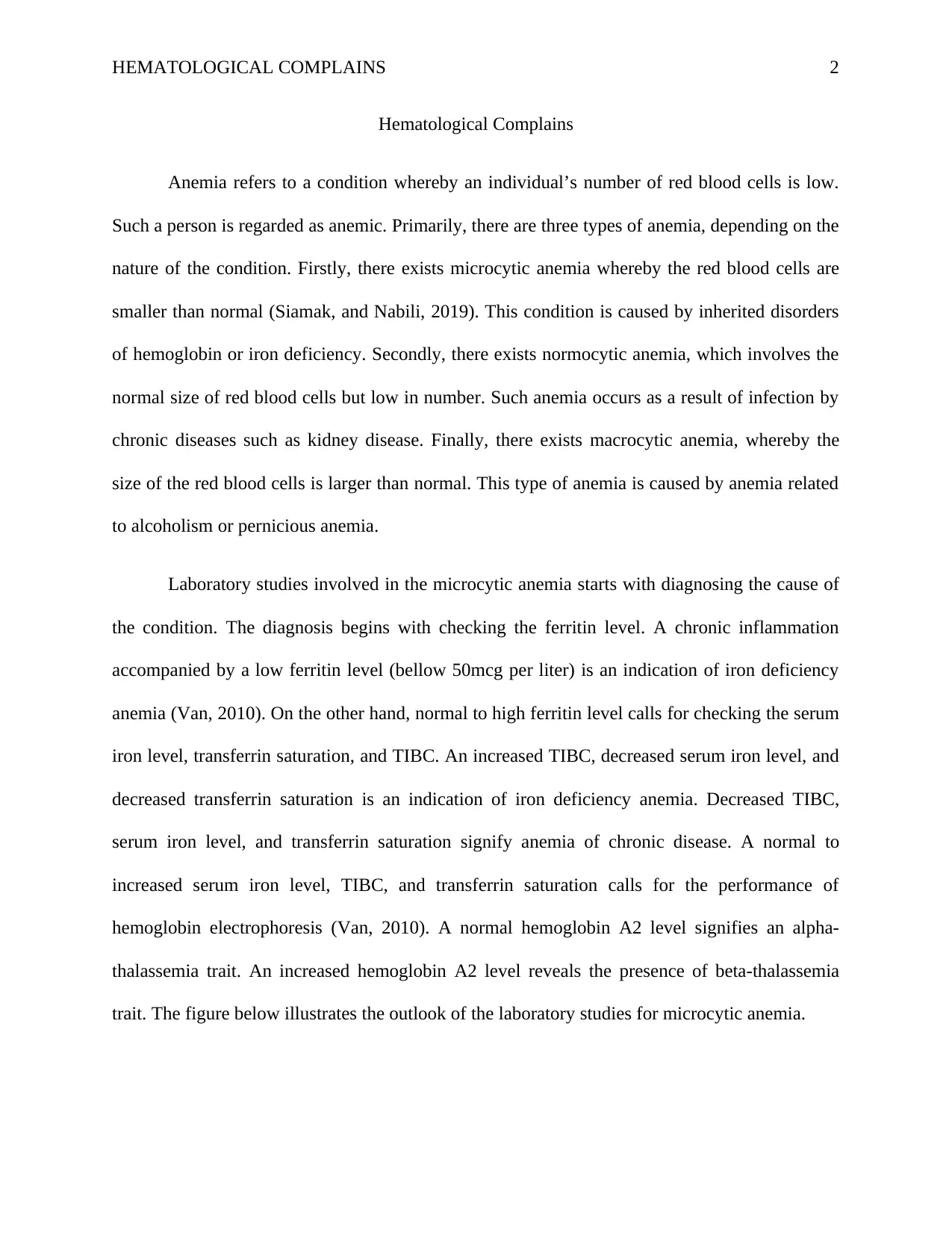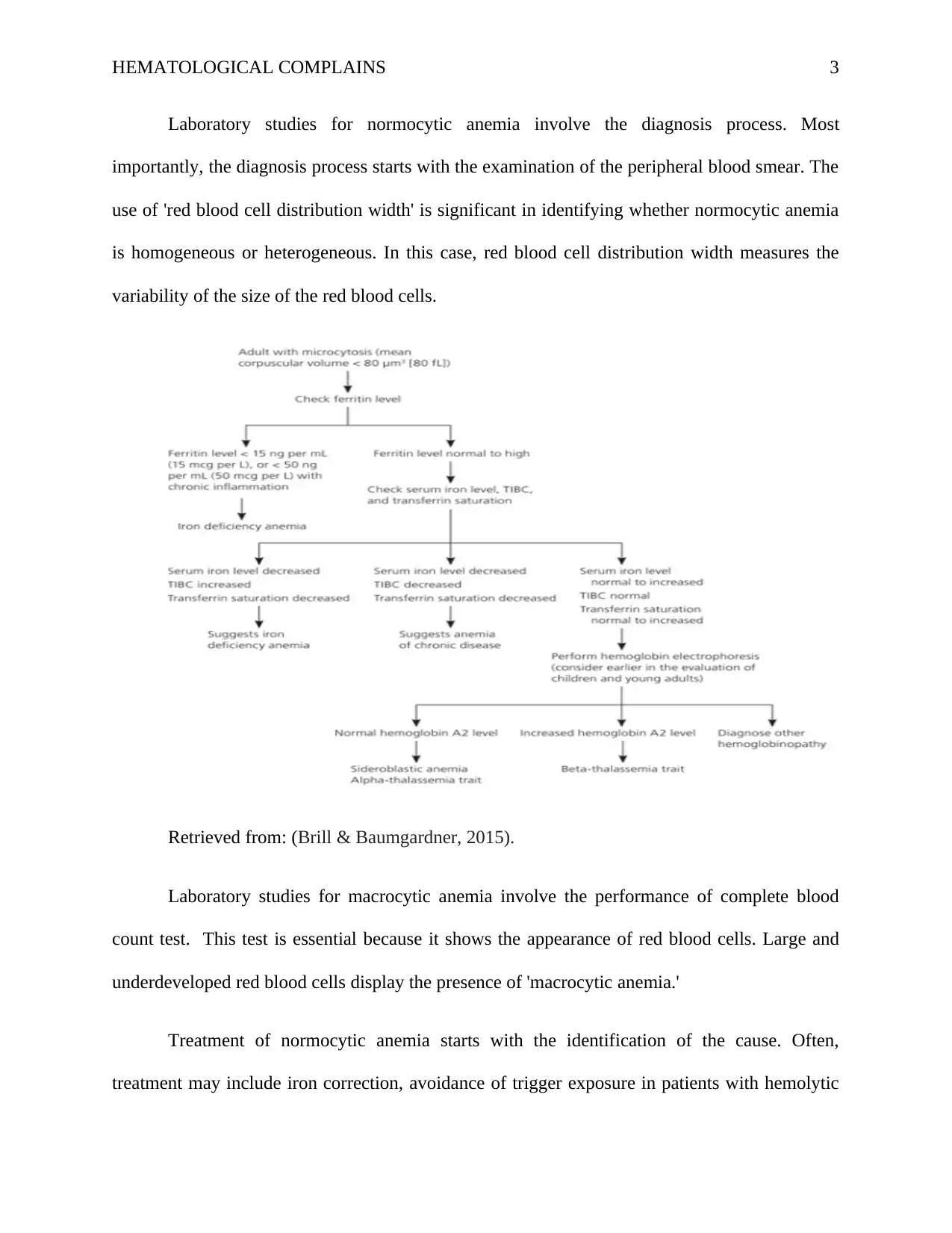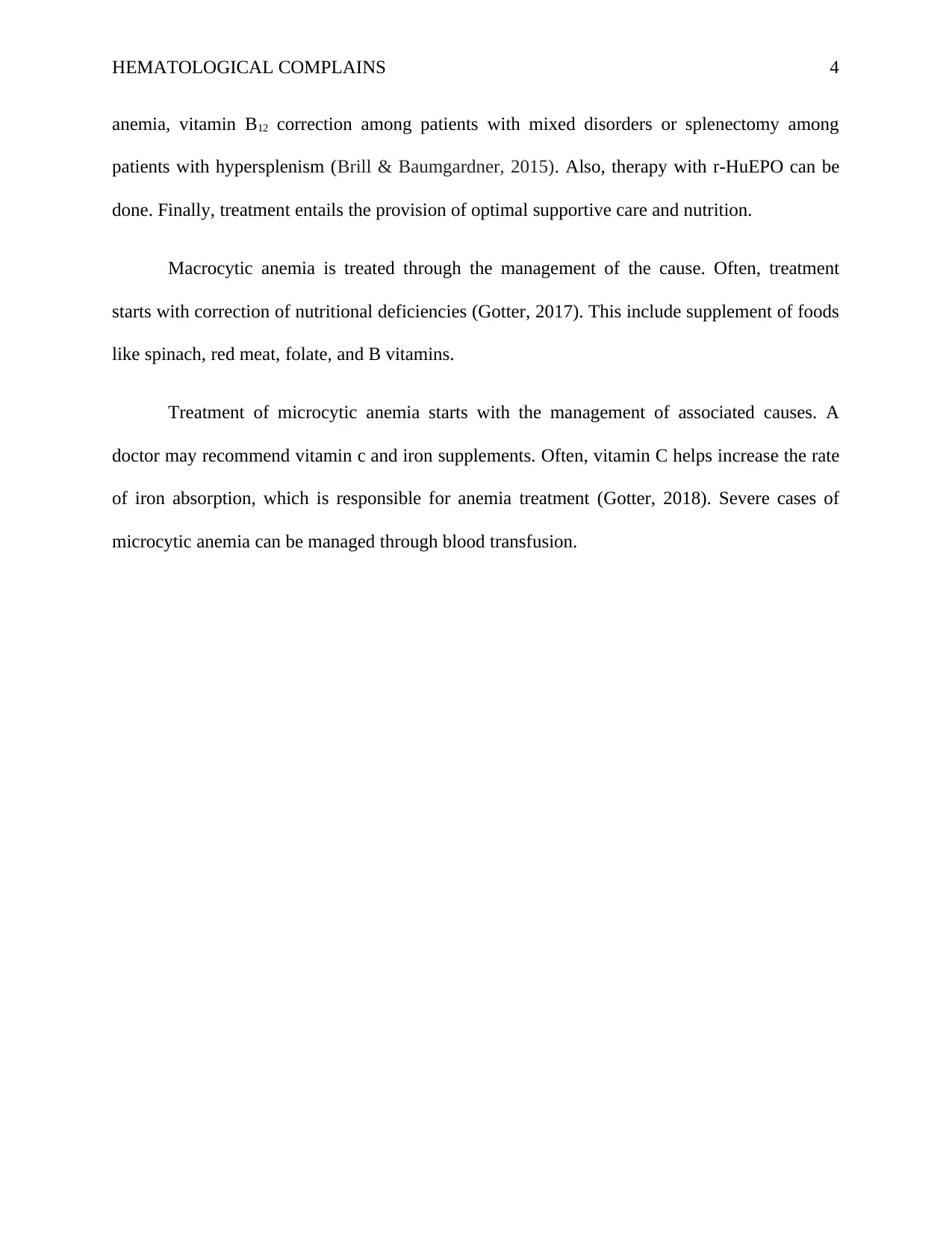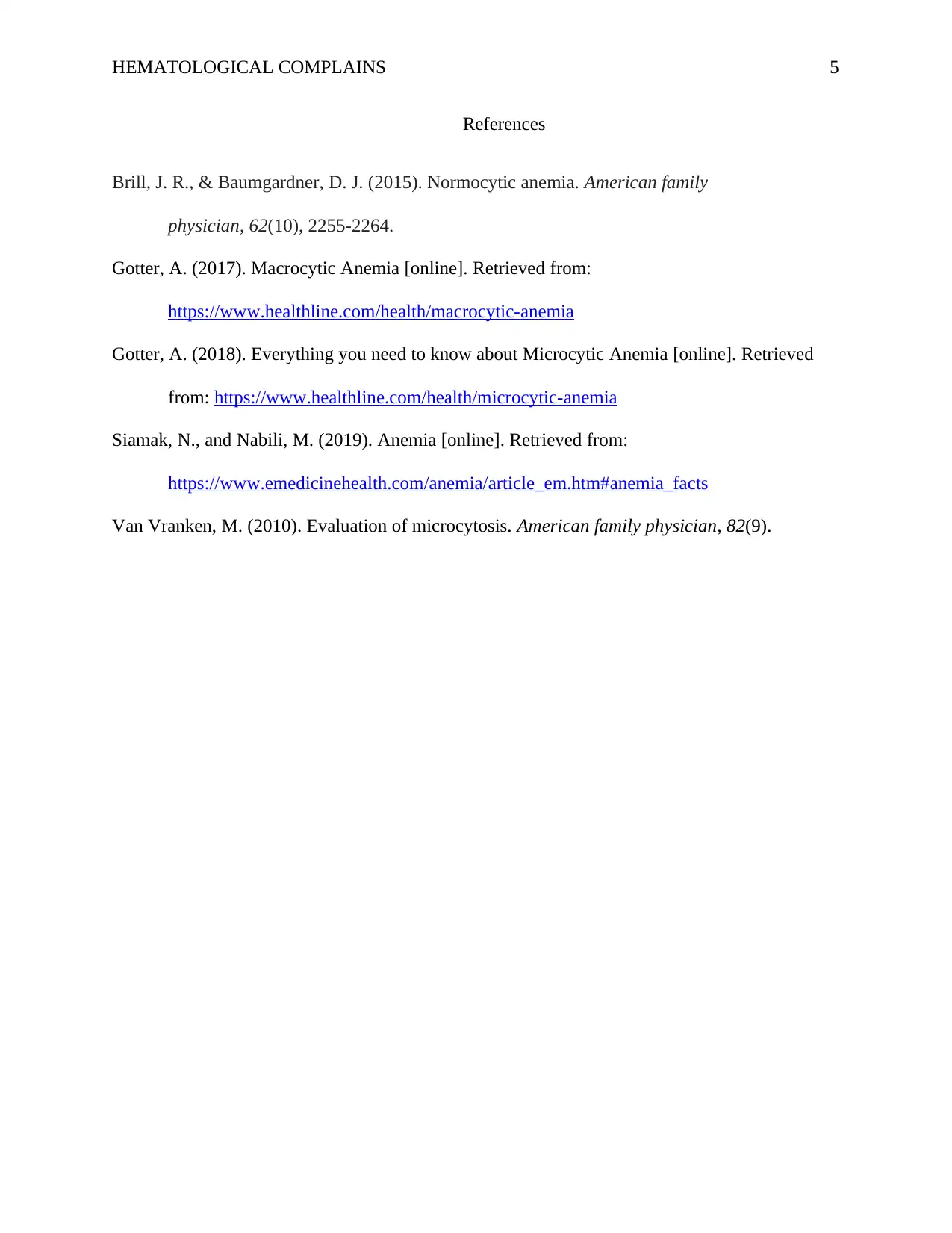Hematological Complains Analysis: Types, Diagnosis, and Treatments
VerifiedAdded on 2022/09/21
|5
|765
|16
Homework Assignment
AI Summary
This assignment provides a detailed overview of hematological complains, specifically focusing on anemia. It begins by defining anemia and then outlines the three main types: microcytic, normocytic, and macrocytic anemia. The assignment explains the causes and characteristics of each type, including the role of red blood cell size and number. It then delves into laboratory studies used for diagnosis, such as ferritin levels, serum iron tests, and complete blood counts. The assignment also covers treatment approaches for each type of anemia, including iron correction, avoidance of triggers, vitamin B12 supplementation, and blood transfusions. The document references several sources to support its findings.

Running head: HEMATOLOGICAL COMPLAINS 1
Hematological Complains
Student’s Name
Institutional Affiliation
Hematological Complains
Student’s Name
Institutional Affiliation
Paraphrase This Document
Need a fresh take? Get an instant paraphrase of this document with our AI Paraphraser

HEMATOLOGICAL COMPLAINS 2
Hematological Complains
Anemia refers to a condition whereby an individual’s number of red blood cells is low.
Such a person is regarded as anemic. Primarily, there are three types of anemia, depending on the
nature of the condition. Firstly, there exists microcytic anemia whereby the red blood cells are
smaller than normal (Siamak, and Nabili, 2019). This condition is caused by inherited disorders
of hemoglobin or iron deficiency. Secondly, there exists normocytic anemia, which involves the
normal size of red blood cells but low in number. Such anemia occurs as a result of infection by
chronic diseases such as kidney disease. Finally, there exists macrocytic anemia, whereby the
size of the red blood cells is larger than normal. This type of anemia is caused by anemia related
to alcoholism or pernicious anemia.
Laboratory studies involved in the microcytic anemia starts with diagnosing the cause of
the condition. The diagnosis begins with checking the ferritin level. A chronic inflammation
accompanied by a low ferritin level (bellow 50mcg per liter) is an indication of iron deficiency
anemia (Van, 2010). On the other hand, normal to high ferritin level calls for checking the serum
iron level, transferrin saturation, and TIBC. An increased TIBC, decreased serum iron level, and
decreased transferrin saturation is an indication of iron deficiency anemia. Decreased TIBC,
serum iron level, and transferrin saturation signify anemia of chronic disease. A normal to
increased serum iron level, TIBC, and transferrin saturation calls for the performance of
hemoglobin electrophoresis (Van, 2010). A normal hemoglobin A2 level signifies an alpha-
thalassemia trait. An increased hemoglobin A2 level reveals the presence of beta-thalassemia
trait. The figure below illustrates the outlook of the laboratory studies for microcytic anemia.
Hematological Complains
Anemia refers to a condition whereby an individual’s number of red blood cells is low.
Such a person is regarded as anemic. Primarily, there are three types of anemia, depending on the
nature of the condition. Firstly, there exists microcytic anemia whereby the red blood cells are
smaller than normal (Siamak, and Nabili, 2019). This condition is caused by inherited disorders
of hemoglobin or iron deficiency. Secondly, there exists normocytic anemia, which involves the
normal size of red blood cells but low in number. Such anemia occurs as a result of infection by
chronic diseases such as kidney disease. Finally, there exists macrocytic anemia, whereby the
size of the red blood cells is larger than normal. This type of anemia is caused by anemia related
to alcoholism or pernicious anemia.
Laboratory studies involved in the microcytic anemia starts with diagnosing the cause of
the condition. The diagnosis begins with checking the ferritin level. A chronic inflammation
accompanied by a low ferritin level (bellow 50mcg per liter) is an indication of iron deficiency
anemia (Van, 2010). On the other hand, normal to high ferritin level calls for checking the serum
iron level, transferrin saturation, and TIBC. An increased TIBC, decreased serum iron level, and
decreased transferrin saturation is an indication of iron deficiency anemia. Decreased TIBC,
serum iron level, and transferrin saturation signify anemia of chronic disease. A normal to
increased serum iron level, TIBC, and transferrin saturation calls for the performance of
hemoglobin electrophoresis (Van, 2010). A normal hemoglobin A2 level signifies an alpha-
thalassemia trait. An increased hemoglobin A2 level reveals the presence of beta-thalassemia
trait. The figure below illustrates the outlook of the laboratory studies for microcytic anemia.

HEMATOLOGICAL COMPLAINS 3
Laboratory studies for normocytic anemia involve the diagnosis process. Most
importantly, the diagnosis process starts with the examination of the peripheral blood smear. The
use of 'red blood cell distribution width' is significant in identifying whether normocytic anemia
is homogeneous or heterogeneous. In this case, red blood cell distribution width measures the
variability of the size of the red blood cells.
Retrieved from: (Brill & Baumgardner, 2015).
Laboratory studies for macrocytic anemia involve the performance of complete blood
count test. This test is essential because it shows the appearance of red blood cells. Large and
underdeveloped red blood cells display the presence of 'macrocytic anemia.'
Treatment of normocytic anemia starts with the identification of the cause. Often,
treatment may include iron correction, avoidance of trigger exposure in patients with hemolytic
Laboratory studies for normocytic anemia involve the diagnosis process. Most
importantly, the diagnosis process starts with the examination of the peripheral blood smear. The
use of 'red blood cell distribution width' is significant in identifying whether normocytic anemia
is homogeneous or heterogeneous. In this case, red blood cell distribution width measures the
variability of the size of the red blood cells.
Retrieved from: (Brill & Baumgardner, 2015).
Laboratory studies for macrocytic anemia involve the performance of complete blood
count test. This test is essential because it shows the appearance of red blood cells. Large and
underdeveloped red blood cells display the presence of 'macrocytic anemia.'
Treatment of normocytic anemia starts with the identification of the cause. Often,
treatment may include iron correction, avoidance of trigger exposure in patients with hemolytic
⊘ This is a preview!⊘
Do you want full access?
Subscribe today to unlock all pages.

Trusted by 1+ million students worldwide

HEMATOLOGICAL COMPLAINS 4
anemia, vitamin B12 correction among patients with mixed disorders or splenectomy among
patients with hypersplenism (Brill & Baumgardner, 2015). Also, therapy with r-HuEPO can be
done. Finally, treatment entails the provision of optimal supportive care and nutrition.
Macrocytic anemia is treated through the management of the cause. Often, treatment
starts with correction of nutritional deficiencies (Gotter, 2017). This include supplement of foods
like spinach, red meat, folate, and B vitamins.
Treatment of microcytic anemia starts with the management of associated causes. A
doctor may recommend vitamin c and iron supplements. Often, vitamin C helps increase the rate
of iron absorption, which is responsible for anemia treatment (Gotter, 2018). Severe cases of
microcytic anemia can be managed through blood transfusion.
anemia, vitamin B12 correction among patients with mixed disorders or splenectomy among
patients with hypersplenism (Brill & Baumgardner, 2015). Also, therapy with r-HuEPO can be
done. Finally, treatment entails the provision of optimal supportive care and nutrition.
Macrocytic anemia is treated through the management of the cause. Often, treatment
starts with correction of nutritional deficiencies (Gotter, 2017). This include supplement of foods
like spinach, red meat, folate, and B vitamins.
Treatment of microcytic anemia starts with the management of associated causes. A
doctor may recommend vitamin c and iron supplements. Often, vitamin C helps increase the rate
of iron absorption, which is responsible for anemia treatment (Gotter, 2018). Severe cases of
microcytic anemia can be managed through blood transfusion.
Paraphrase This Document
Need a fresh take? Get an instant paraphrase of this document with our AI Paraphraser

HEMATOLOGICAL COMPLAINS 5
References
Brill, J. R., & Baumgardner, D. J. (2015). Normocytic anemia. American family
physician, 62(10), 2255-2264.
Gotter, A. (2017). Macrocytic Anemia [online]. Retrieved from:
https://www.healthline.com/health/macrocytic-anemia
Gotter, A. (2018). Everything you need to know about Microcytic Anemia [online]. Retrieved
from: https://www.healthline.com/health/microcytic-anemia
Siamak, N., and Nabili, M. (2019). Anemia [online]. Retrieved from:
https://www.emedicinehealth.com/anemia/article_em.htm#anemia_facts
Van Vranken, M. (2010). Evaluation of microcytosis. American family physician, 82(9).
References
Brill, J. R., & Baumgardner, D. J. (2015). Normocytic anemia. American family
physician, 62(10), 2255-2264.
Gotter, A. (2017). Macrocytic Anemia [online]. Retrieved from:
https://www.healthline.com/health/macrocytic-anemia
Gotter, A. (2018). Everything you need to know about Microcytic Anemia [online]. Retrieved
from: https://www.healthline.com/health/microcytic-anemia
Siamak, N., and Nabili, M. (2019). Anemia [online]. Retrieved from:
https://www.emedicinehealth.com/anemia/article_em.htm#anemia_facts
Van Vranken, M. (2010). Evaluation of microcytosis. American family physician, 82(9).
1 out of 5
Related Documents
Your All-in-One AI-Powered Toolkit for Academic Success.
+13062052269
info@desklib.com
Available 24*7 on WhatsApp / Email
![[object Object]](/_next/static/media/star-bottom.7253800d.svg)
Unlock your academic potential
Copyright © 2020–2025 A2Z Services. All Rights Reserved. Developed and managed by ZUCOL.




